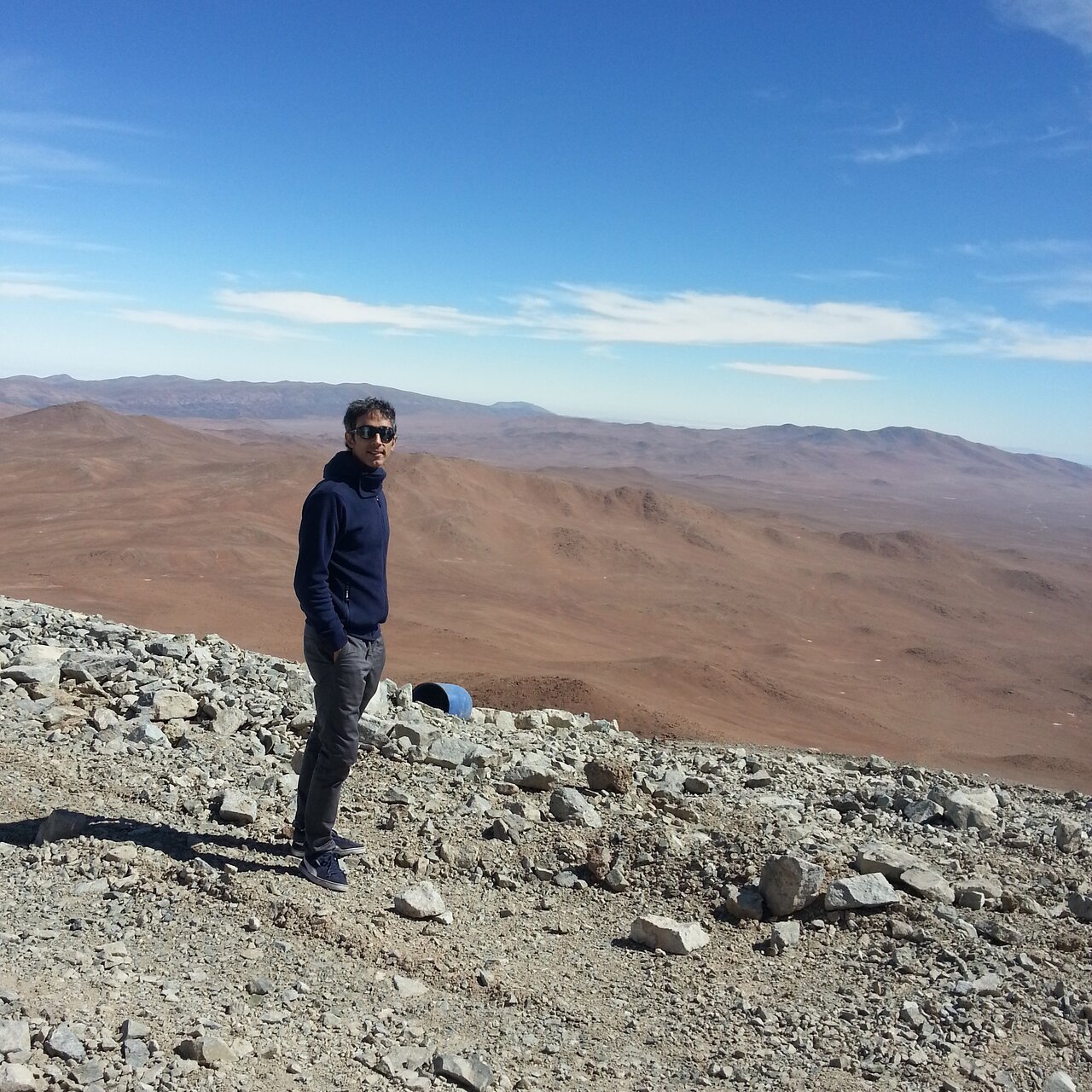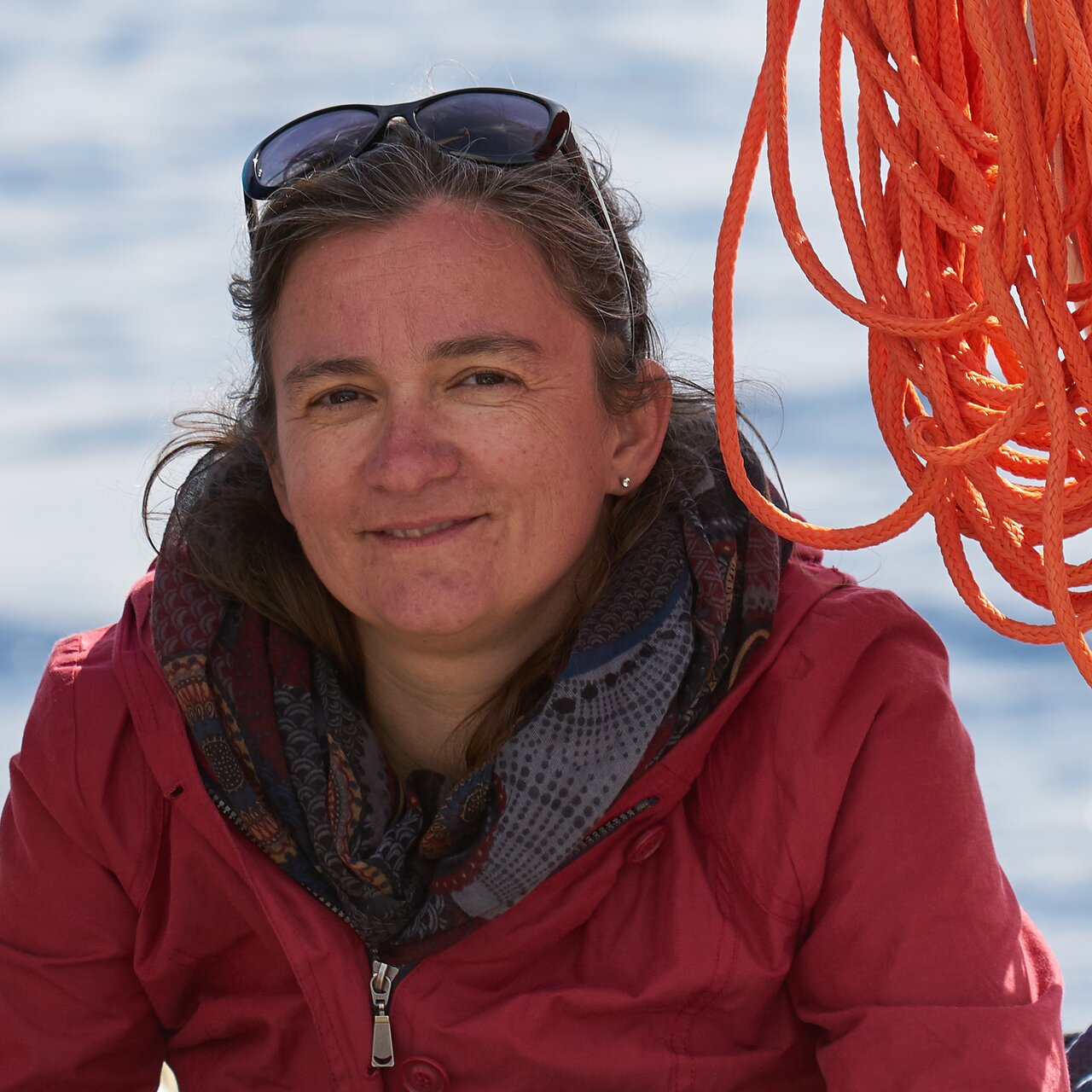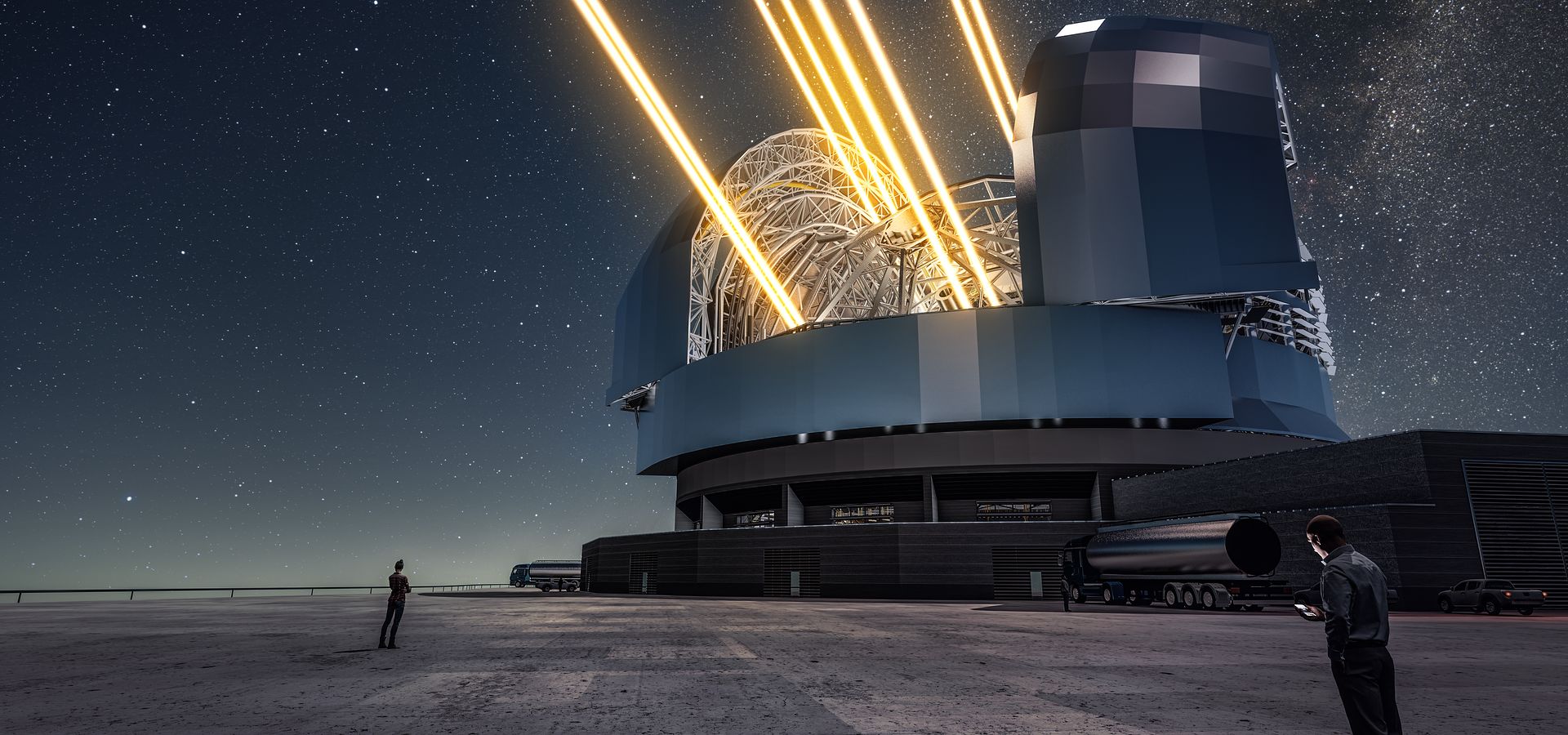- How thinking big and aiming high is creating the “world’s biggest eye on the sky”
- What the day-to-day work looks like for some of those working on ESO’s ELT
- Some of the rewarding aspects of working in science and on ESO’s ELT
- How ESO scientists, engineers and technicians found their careers in astronomy
Emanuela Ciattaglia (ELT Assembly, Integration and Verification Manager)
Lorenzo Pettazzi (Control Engineer)
Juan Carlos Palacio (Mechanical Construction Engineer)
Alain Delorme (Contracts and Procurement Officer)
Elise Vernet (Adaptive Optics Expert)
Mark Wallace (Expert Control System Engineer)
Fabio Biancat Marchet (Programme Engineer)
Amelie Gnatz (Document Controller)
Emanuela Ciattaglia (ELT Assembly, Integration and Verification Manager)
 Emanuela on top of Cerro Armazones in 2016.
Credit: ESO/Emanuela Ciattaglia
Emanuela on top of Cerro Armazones in 2016.
Credit: ESO/Emanuela Ciattaglia

Since the end of 2016, I have been leading a great, expert team in planning the Assembly, Integration and Verification phase of the ELT on site. This is when all telescope subsystems are assembled together for the first time, and the telescope is finally “switched on” and tuned to get ready to bring distant objects closer to us.
Since I was a child, I’ve been fascinated with how everything works and kept following my dad repairing cars and things around the house. Studying mechanical engineering meant my fascination finally found some solid explanations in understanding how things can be put together to achieve a function.
Before the ELT, I worked on ALMA. My first visit to the ALMA site, high up on the Chajnantor plateau, felt like being on another planet, and yet the antennas we had worked on for so long were right there, moving together beautifully.
Now, I really enjoy that my work on the ELT gives me a wide overview of the first part of the telescope’s life on site: from the arrival of various components, to their assembly and testing, until they are all serving their special functions together in this fantastic machine. Currently, my work days are full of meetings with the team, and the many teams we interface with, to plan the work on site. It is pretty dynamic, with numerous exchanges on many different topics, challenging at times but extremely interesting!
A very memorable moment was back in 2016: being on the flattened top of Cerro Armazones for the first time was thrilling! I walked across it, thinking about how the work of ESO, all the contractors across many countries and everyone supporting us would one day materialise into a gigantic telescope on that exact soil. In the future, we will be back on that mountain top with so much more experience (and grey hair!), and able to admire the result of all our amazing work.
Outside work, my family lovingly fills my time. We love trying out different sports together and repairing our cars and bikes. When I have the time, I like playing piano, painting and learning about neuroscience discoveries.
Lorenzo Pettazzi (Control Engineer)
 Lorenzo Pettazzi, the first time he visited the Cerro Armazones site in 2016.
Credit: ESO/Lorenzo Pettazzi
Lorenzo Pettazzi, the first time he visited the Cerro Armazones site in 2016.
Credit: ESO/Lorenzo Pettazzi

When you are an engineer any moment you spend in the field is a memorable one, because it very often represents a big step in your personal “learning curve”. ESO’s Paranal Observatory is a very special place where engineers and astronomers are learning every day how to push the limits of technology to refine the art of astronomical observation and expand our knowledge of the Universe. We can use our knowledge and experience from building and operating the VLT at Paranal Observatory in constructing the ELT at Cerro Armazones.
My fascination with space exploration drew me to study aerospace engineering at the age of 18. Now as a control engineer for the ELT, I am involved in designing and building the devices necessary to move the giant optical elements of the telescope. In particular I am the Workpackage Manager for the M1 Position Actuators, which will control the fine motions of each of the 798 segments of the ELT’s main mirror. The complexity of the projects means my work days are always different! Sometimes I spend the day in the lab testing future ELT actuators, other times I work at my computer simulating the performance of the telescope’s algorithms. I also coordinate the work of colleagues or external contractors to complete these projects. I enjoy working side by side with very talented professionals on the development of cutting edge technologies. The idea of building a unique facility which will shape future astronomical research always keeps me motivated.
When I am not working at ESO, I enjoy sports including tennis, football, snowboarding and jogging. I sometimes relax by practising my juggling skills, reading comics or taking part in outdoor activities with my family. Last but not least, I am an enthusiastic supporter of AS Roma, the football team of my hometown!
Juan Carlos Palacio (Mechanical Construction Engineer)
 Juan Carlos Palacio enjoying the Bavarian landscape on his bike.
Credit: ESO/Fernando Gago
Juan Carlos Palacio enjoying the Bavarian landscape on his bike.
Credit: ESO/Fernando Gago

Growing up, there wasn’t much to do in the village I lived in in southern Chile — no internet or video games and it rained all winter, so I spent my time trying to understand physical processes and playing with numbers to solve equations. After high school, I started to study engineering, which narrowed down to mechanical engineering after I was delighted by all of the thermal processes and fluid mechanics in a course of thermodynamics.
I am now a mechanical construction engineer, which involves participating in technical reviews for the ELT’s dome and main structure and other subsystems. A typical day is spent reviewing mechanical designs and calculations in documentation delivered by contractors, as well as revising the maintainability and reliability of equipment; this is very important to ensure that the time the ELT spends on-sky collecting data for astronomical research is maximised. After working on the VLT at Paranal Observatory for 15 years, I am trying to transfer the experience I gained by contributing information about the typical issues we have faced with the VLT.
For me, the most remarkable part of the ELT project so far was seeing the first design of the dome rotation mechanism. We have developed this to be able to hold and rotate the telescope’s dome, which will have a mass of more than 6100 tonnes! Participating in meetings with contractors and evaluating their designs is an enjoyable learning process because they bring new ideas that they have implemented in projects in totally different sectors, which opens our minds to investigate whether such technology could be useful for the ELT.
Alain Delorme (Contracts and Procurement Officer)
 Alain Delorme playing pétanque at the Atomiade, an event where many European research institutes gather to play sports.
Credit: ESO/Alain Delorme
Alain Delorme playing pétanque at the Atomiade, an event where many European research institutes gather to play sports.
Credit: ESO/Alain Delorme

My educational background is in economics, and I started working in a sales department. Then one day I had an opportunity to switch to the other side, the purchasing part, first in a commercial business then for the French Ministry of Defence, where I processed the procurement part of high-technology equipment. And I just loved it! When I applied to ESO, the organisation was looking for an engineer with some procurement experience. Instead, I offered strong procurement experience in technological areas.
Even though I’m not an engineer, I enjoy the technological side of my work. I like to understand what I’m working on, not only my part — the procurement process and commercial and contractual aspects — but also the technical issues, constraints and implications, hence I appreciate the discussions with my colleagues in charge of the technical aspects of the project I am involved in. I also very much like having to deal with a variety of issues and areas. The ELT offers all of that.
I was specifically recruited in 2010 for the ELT. Although my tasks extend beyond that project, I am heavily involved in ELT procurements since it represents a significant part of our activities. Currently, I am in charge of many of the commercial aspects of the ELT’s different mirrors, including their polishing, coating and washing — the mirrors are very complex so this is a surprisingly large amount of work! My job consists mainly of processing recurring tasks and procurements of systems which usually conclude after a long tendering process. In all cases, I am happy when I consider the outcome of a process satisfactory for ESO. There is a mixture of small and bigger satisfactions. Of course when you witness important milestones of a contract (for example the first blasting of Cerro Armazones), or conclude a negotiation after a process which is complex (the polishing of the primary mirror) or difficult (the edge sensors), these are memorable moments!
Elise Vernet (Adaptive Optics Expert)
 Elise Vernet on a boat.
Credit: ESO/Elise Vernet
Elise Vernet on a boat.
Credit: ESO/Elise Vernet

As a teenager, I was an amateur astronomer and built a small Dobsonian telescope, which led me to studying physics at university. In my last year, I specialised in high angular resolution astronomy, which introduced me to adaptive optics systems, an essential technology to achieve sharper images. It was in 1997 and ESO’s 3.6-metre telescope at La Silla Observatory was just providing its first results using this technology. I found it amazing that we could overcome the effects of the atmosphere, using very fast mirrors and sensors to get higher resolution images as if we were observing from space rather than from the ground.
Now, I continue to work with adaptive optics systems on the ELT. I am responsible for two of the ELT’s five mirrors: the adaptive M4 mirror and the ultralight weight M5 mirror. These two critical subunits are designed and manufactured by external companies, so on a typical day I follow up on the projects, read documents and attend meetings with the companies to try help solve technical issues and find out any risks which could delay the project or increase its cost. As some components of both subunits are already being manufactured and assembled, I am also verifying they meet requirements.
I really enjoy following up on state-of-the-art projects like the ELT. I do my best to get the very technologically challenging components delivered to specification and on time. I like that every day I’m improving my technical knowledge on aspects of manufacturing and integration, and I enjoy helping test and inspect each subsystem. The most memorable moment in my career so far was back when I was working on the VLT. Installing the deformable secondary mirror on the VLT’s Unit Telescope 4 to provide images corrected for atmospheric effects, gave a second life to the telescope.
Outside of work, I like making clothes for my whole family. I also have a lot of fun cooking international recipes and visiting foreign countries.
Mark Wallace (Expert Control System Engineer)
 Mark Wallace out walking with his puppy, Tilly.
Credit: ESO/ Mark Wallace
Mark Wallace out walking with his puppy, Tilly.
Credit: ESO/ Mark Wallace

My role involves developing the Interlock and Safety System, which covers the safety interactions of all ELT subsystems to keep both people and the equipment safe. For example, ensuring that the lasers cannot be switched on if people are inside the dome to avoid exposing them to potentially harmful radiation or ensuring that the altitude structure (telescope tube) cannot move while M1 segments are being exchanged to protect the people and mirror segments involved. A typical day involves writing or reviewing design reports and technical memos, testing various hardware configurations and the odd meeting.
What I enjoy most about my work is being challenged by unusual problems and learning new things. The juxtaposition of the sheer size of the ELT, the requirements on accuracy and precision, and the harsh range of environmental conditions on Cerro Armazones creates myriad challenges. Talking to and working with others at ESO provides plenty of opportunities to learn from their experience.
I have always enjoyed solving puzzles and in high school, I saw that a career in engineering meant solving real-world problems. I was set on aeronautical engineering, even applying to the Australian Defence Force Academy. In the end, I opted for mechatronics engineering to defer choosing my specialty. Taking mechatronics gave me the opportunity to work on a variety of machines, including making Joint Strike Fighter components. The experience I gained in motion control and functional safety in industry led to my involvement in the ELT.
A highlight in my career was prototyping large-scale 3D printing combined with 5-axis machining to print large structures quickly and accurately. The tough requirements made every step towards success more rewarding. For the ELT, seeing the site first-hand gave me a better feeling of the project’s enormity than drawings or 3D models ever could.
Outside work, we recently got a puppy. Meeting other dogs (and their owners) in the park allows me to practice German. I also like skiing and sledding with my kids. My colleagues may not know, but I used to row competitively and if I could find time here in Munich, I would love to get back into it.
Fabio Biancat Marchet (Programme Engineer)
 Fabio Biancat Marchet at work in his office.
Credit: ESO/ Fabio Biancat Marchet
Fabio Biancat Marchet at work in his office.
Credit: ESO/ Fabio Biancat Marchet

From the mist of my early memories, I can distinguish the blurred image of that first “small step for man” on an alien world, which probably inspired my future. As a child, I was attracted by the complexity of systems, by the interactions between them and by their intrinsic mechanisms and the possibility of creating new ones.
I started working for the ELT in 2017 as the Programme Engineer. My duty is mainly to coordinate the efforts of a number of experts and I spend my days communicating with colleagues and contractors or reviewing documentation. What makes this job challenging is the fact that often decisions have to be made relying on partial information and compromises have to be found among conflicting constraints.
Besides the obvious pride of contributing to one of the biggest scientific enterprises ever, what gratifies me most is the productive interaction with people and feeling part of a team that shares a common objective; where everyone contributes with their own unique skills, background, character and culture. I’m convinced that, whether you’re building advanced astronomical facilities, cars, or washing machines, this is what really enriches you.
For me, engineering should involve working towards a higher respect for the environment. Visiting the ELT construction site for the first time was a breathtaking experience, and not just because of the over 3000-metre elevation; only there looking at the huge hole in the mountain can one grasp the true breadth of the project. And the depth of that scar reminds us of our responsibility to develop not yet another monument to the arrogance of mankind, but rather a sign of its thirst for knowledge.
To take my mind off work and relieve the stress, I like to cook, which I find simultaneously challenging and relaxing. And after all, cooking has a lot in common with being an ELT engineer; it requires ingenuity, planning, staying within a budget and schedule, and — most importantly — satisfying customers.
Amelie Gnatz (Document Controller)
 Amelie Gnatz
Credit: ESO/Amelie Gnatz
Amelie Gnatz
Credit: ESO/Amelie Gnatz

As the ELT Document Controller, I am responsible for keeping the ELT document repository updated and the ELT documents accessible to the authorised users. My goal is to support the ELT staff with documentation matters and ensure the accuracy, quality and integrity of the ELT documents. In cooperation with the project managers and the managers responsible for the different components of the ELT, I take care of the documents delivered by external parties for reviews and prepare documentation packages for procurements. As part of the Systems Engineering Team I am involved in configuration management processes ensuring that the system will perform as intended, and is identified and documented in sufficient detail.
While documentation is a topic that tends to be overlooked, it plays a key role in each and every project and at each stage of the project. Having in place a well-maintained repository ensures a common source of truth to work with and enables the project to evolve smoothly. Long story short, the ELT repository has the aim to make our lives at the ELT easier.
The ELT is an unique and complex project that is evolving fast. The repository structure and how we manage the processes of documentation and configuration management need to be constantly adjusted according to the project’s evolution. This makes my role very varied and interesting. Aside from my day-to-day work in Garching, I will never forget my trips to Chile, where I had the chance to see Cerro Armazones — the new ELT site — after the mountain plateau was created. But I think the most memorable moment is yet to come: seeing the complete ELT for the first time.
Numbers in this article
| 15 | The number of years that Juan Carlos Palacio worked on the VLT at Paranal Observatory. |
| 798 | Number of segments in the ELT’s main mirror. |
| 2010 | The year that Alain Delorme was recruited for the ELT. |
| 2016 | The year that Emanuela Ciattaglia and Lorenzo Pettazzi visited the flattened top of Cerro Armazones for the first time. |
| 2017 | The year Fabio Biancat Marchet started working for the ELT in 2017 as the Programme Engineer. |
| 3046 | Altitude of the ELT at Cerro Paranal in metres. |
| 6100 | The number of tonnes that the ELT’s dome weighs. |

